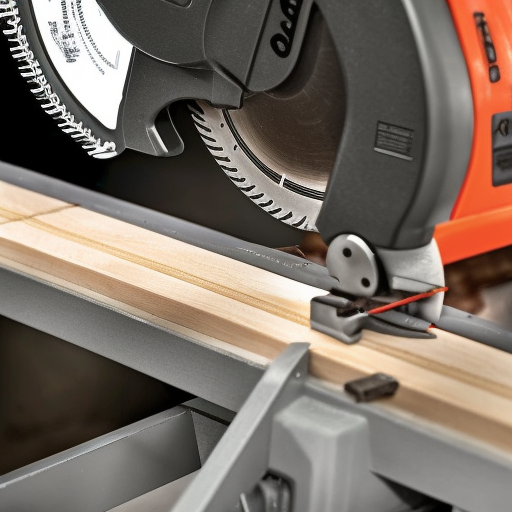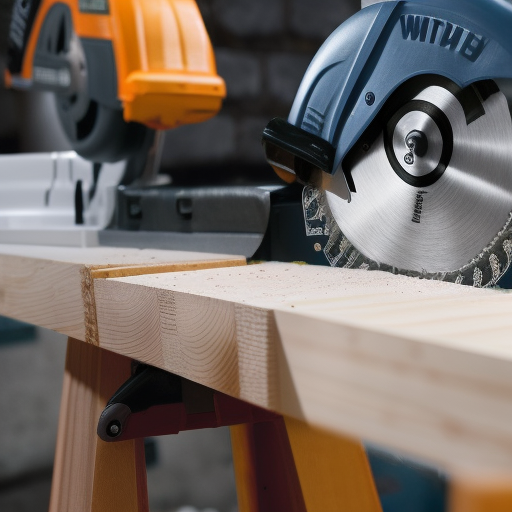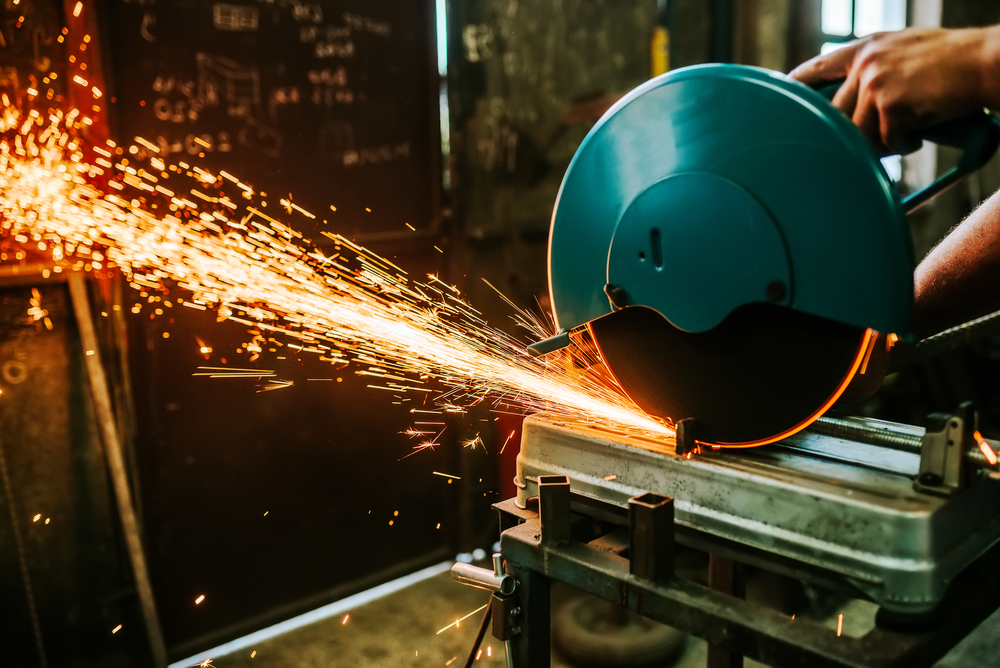Last Updated on February 6, 2023
Do you ever look at a mitre saw and wonder just how deep it can cut? Well, if so, then this blog post is for you. We’ll be exploring the different types of mitre saws and their respective cutting depths. Plus, we’ll cover safety tips to help ensure your project goes off without any mishaps. Finally, we will discuss some key techniques to make sure that each cut with your trusty mitre saw comes out perfectly accurate every time – no more guesswork or trial-and-error involved. So join us as we answer the question, “How deep can a mitre saw cut?”
Table of Contents:
- Types of Mitre Saws and Their Cutting Depths
- Safety Tips for Using a Mitre Saw
- Tips for Making Accurate Cuts with a Mitre Saw
- Common Mistakes When Using a Mitre Saw
- Conclusion
Types of Mitre Saws and Their Cutting Depths
Mitre saws are versatile tools used for making accurate crosscuts and mitres in wood, metal, plastic, and other materials. They come in a variety of sizes and styles to suit different projects. Knowing the types of mitre saws available and their cutting depths can help you choose the right one for your project.
The most common type of mitre saw is the standard mitre saw, which has two blades mounted on an arm that pivots from side to side. This type of saw can make both crosscuts (cutting across the grain) and mitres (angled cuts). The size of these blades determines their cutting depth – typically between 4”-6” deep, depending on blade size. It’s important to note that larger blades will require more power than smaller ones, so it’s best to match your power source with the blade size you need for your project.
Another popular type is the compound mitre saw, which adds an additional pivot point allowing users to make bevelled cuts as well as angled ones. These are great for creating complex mouldings or trim work where multiple angles are needed, such as crown moulding or window casings. Compound mitre saws have deeper cutting capacities than standard models ranging from 6”-12” depending on blade size, but they also require more power due to their increased complexity.
For even greater accuracy when working with large pieces, sliding compound mitre saws offer extra support by allowing you to slide material along a track while making bevelled cuts at any angle up to 45 degrees left or right without having to reposition it manually each time, like with regular compound models. Sliding compound mitre saws have some of the deepest cutting capacities reaching up 16″ – 18″ depending on blade size, but they also tend to be heavier than other types due to higher motor requirements, so keep this in mind if portability is an important factor for you when selecting one.
Finally, there are dual compound mitre/sliding compound mitre hybrid models which combine all three features into one unit offering maximum versatility when dealing with large pieces requiring multiple angles plus long straight cuts too. Dual compounds usually have very deep cutting capacities ranging from 12″-20″, again dependent upon blade size, but just like sliding compounds, they’re much heavier due to their powerful motors, so take this into consideration before investing in one.
Choosing the right mitre saw depends largely on what kind of project you plan on tackling – whether it’s basic trim work around windows or something more complex like crown moulding. Understanding how each model works will help ensure success no matter what job you decide to tackle next.
Mitre saws come in various sizes and shapes, each with its own cutting depth capabilities. To ensure the safe operation of your mitre saw, make sure to follow the safety tips outlined in the next section.
Safety Tips for Using a Mitre Saw
Using a mitre saw can be dangerous if you don’t take the proper safety precautions. Before using your saw, make sure to wear protective gear such as safety glasses and hearing protection. It is also important to set up a safe work area by clearing away any debris or obstacles that could interfere with the cutting process.

When operating the saw, always follow manufacturer instructions for best results and safety. Make sure to use clamps or other devices to secure materials in place before making cuts; never attempt to hold them in place while cutting. Additionally, keep hands away from the blade at all times when it is running; this will help prevent accidental contact with sharp blades and kickback of material during operation.
It’s also important not to force the blade through materials as this can cause binding, which may result in injury or damage to equipment. If possible, use a push stick when making long cuts so that you don’t have your hands close enough for an accident should something go wrong with the cut itself or the machine itself fails suddenly due to mechanical issues like worn out bearings etc.
Finally, inspect your mitre saw regularly for signs of wear and tear, including loose screws and bolts on handles, guards, fences etc., as well as any frayed cords or cables that may need replacing immediately for optimal performance and safety reasons alike.
When using a mitre saw, it is important to take all necessary safety precautions. Now that you are familiar with the safety tips for using a mitre saw, let’s look at some tips for making accurate cuts.
Tips for Making Accurate Cuts with a Mitre Saw
Accurate cuts are essential when using a mitre saw, and there are several steps you can take to ensure that your cuts are precise.
First, it’s important to secure the material you’re cutting. Clamps will help keep the material in place while you make your cut, preventing any unwanted movement or shifting which could lead to an inaccurate cut. If possible, use two clamps – one at each end of the piece being cut – for extra stability.

Next, double-check all measurements before making each cut. Measure twice and cut once. This is especially important if you’re working with multiple pieces of wood that need to fit together perfectly later on in the project; even a small miscalculation can throw off the entire assembly process down the line.
Finally, always remember to wear safety glasses when operating a mitre saw. Not only do they protect against dust particles flying into your eyes, but they also shield them from any potential kickback caused by incorrect technique or faulty equipment operation.
Common Mistakes When Using a Mitre Saw
Using a mitre saw is an essential skill for any DIYer or a professional carpenter. It’s important to be aware of the common mistakes people make when using one, as these can lead to inaccurate cuts and even injury.
Not Checking Blade Alignment
One of the most common mistakes when using a mitre saw is not checking that the blade is properly aligned with the fence before making a cut. If it isn’t, you won’t get accurate results and could potentially damage your workpiece or, worse, injure yourself. To check alignment, use a square and adjust accordingly until it’s perfect.
Failing to Use The Correct Blade For The Material Being Cut
Another mistake many people make is failing to select the correct blade for their material type. Different materials require different blades in order to achieve clean cuts without damaging either the material or your saw itself. Make sure you know what kind of blade works best for each job before starting out.
Not Using Safety Equipment Properly
It’s also important to remember that safety equipment should always be used when operating a mitre saw – no exceptions. That means wearing eye protection at all times while cutting and ensuring that all guards are in place and functioning correctly before beginning any project. Additionally, never reach over or around moving parts on your machine; instead, wait until they have stopped completely before proceeding with whatever task you’re working on at hand.
Forgetting To Measure Twice And Cut Once
Finally, don’t forget about measuring twice and cutting once – this age-old adage still holds true today. Before making any cut on your workpiece, double check measurements against plans or drawings so that you don’t end up wasting time (and possibly money) by having to redo something due to incorrect sizing later down the line.
Conclusion
With the right safety precautions and proper technique, you should have no problem cutting whatever material you need with confidence. Knowing how deep your mitre saw can cut will help ensure that all of your projects are successful.
Paul is the type of person who never met a problem he couldn’t fix. He can always be found tinkering with something in his house, even if it isn’t broken! His tips and tricks are often shared on our site. He’s the one you call when something breaks because he has been known to improvise fixes for everything from leaky faucets to malfunctioning dryers.

